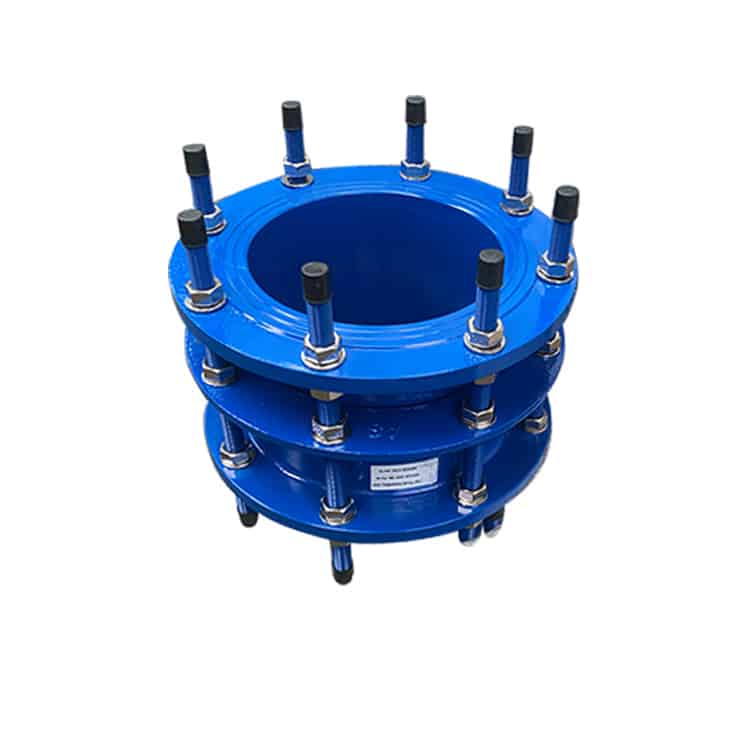
What are Dismantling joints and uses
Dismantling joints are essential components of a pipeline. When it becomes necessary to repair or replace critical elements in the pipeline, such as valves, water meters, flow meters, and others, a gap needs to be created between the flange of these elements and the pipeline. In such cases, dismantling joints are required as they are a unique product designed specifically to facilitate the creation of this gap. This gap is created by adjusting the length of the dismantling joint.
Dismantling joints consist of a protruding flange and a flange adapter. When the protruding flange moves towards the flange adapter, the length of the protruding flange enters inside the flange adapter, and the length of the joint becomes shorter. When the protruding flange moves in the opposite direction of the flange adapter, the length of the protruding flange exits the flange adapter, and the length of the joint becomes longer.
Coating material for dismantling joints:
For natural fluids such as water, oil, and gas at room temperature, a regular FBE coating is suitable. Corrosive or high-temperature chemicals require special surface treatments. For seawater, the interior can be lined with epoxy, and the exterior should be coated with corrosion-resistant coating or with epoxy glass flake coating on both the inside and outside. Strongly acidic fluids, corrosion-resistant nylon type 11 is the best choice. For fluids with temperatures exceeding 100 degrees Celsius, heat-resistant epoxy powder should be used. For pipelines with high contamination, an abrasion-resistant polyurethane inner lining should be used.
Material used for manufacturing dismantling joints:
If the working pressure rating of your pipeline is ≤ 25 bars, a ductile iron joint is the preferred choice due to its wide versatility, corrosion resistance, and competitive price. However, if the working pressure rating is ≥ 40 bars, you should choose a steel joint to withstand the high pressure. The steel material can be carbon steel, stainless steel, or other steel alloys.
Importance of using dismantling joints
The use of dismantling joints plays a crucial role in the design and implementation of pipeline systems that involve valves, pumps, and measuring meters. These double-flanged pipes allow for the necessary longitudinal adjustment. It can be secured at the desired length using the provided tie bars.
The purpose of using dismantling joints is to facilitate the installation and removal of pipeline valves and components. These joints provide the longitudinal adjustment, making it possible to insert the valve into the desired section of the pipe.
This adjustment also assists in properly aligning the valve next to the joint. That can be adjusted to the appropriate length before securely connecting it to the flanges. The reverse sequence is used for the dismantling process, as readjusting the length of the dismantling joint provides enough space for loosening and removing the valve.
In both cases, dismantling joints ensures quick installation and dismantling, ultimately increasing efficiency and reducing downtime. The procedure is carried out in the same way as connecting pipe sections together. Some dismantling joints can also be used without imposing constraints on flexible pipeline systems.
Furthermore, dismantling joints can also be useful in filling gaps. For example, when installing a pump in a permanent location, it needs to be connected to a pipe protruding from the wall.
The basic design principle of these joints:
There may be various versions of dismantling joints available to suit different applications. But the fundamental design principle for all of them is the same, which includes:
- A flange adapter on one side of the joint is securely connected to the pump or valve using a flange.
- The F-piece or the central flange known as the pivotal flange on the other detachable end of the joint to connect in the opposite direction, also pushed into the flange adapter.
- To install or remove valves with longitudinal adjustment up to ±25mm, these two components can be pushed towards each other until the detachable joint is secured between the pipe parts or the valve and the pipe.
- Provided tie bars are used to restrain and connect the flanges for appropriate use of the dismantling joints. At the same time, they also assist in transferring the force occurring on one side of the joint to the other side.


























